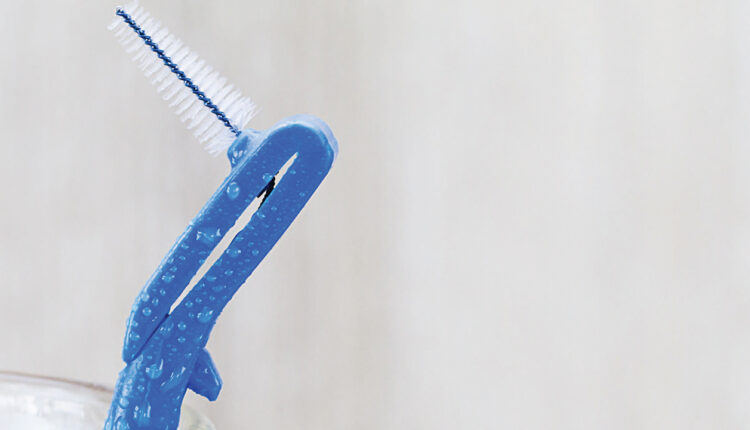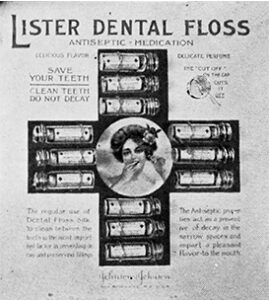 SHARK_749/ISTOCK/GETTY IMAGES PLUS
SHARK_749/ISTOCK/GETTY IMAGES PLUS
A New Paradigm in Interproximal Plaque Removal
Many floss alternatives are available that may help improve compliance and outcomes.
Floss has long been the primary device recommended for cleaning between teeth as part of patients’ daily self-care regimens. Floss has its origins in New Orleans when in 1819, Levi Spear Parmly, DDS, published the book, A Practical Guide to the Management of the Teeth. He recommended that patients use a waxed silk thread “to dislodge that irritating matter which no brush can remove, and which is the real source of disease.”1 In 1882, unwaxed silk floss became commercially available and, in 1898, the first dental floss patent was granted1 (Figure 1). The utilization of silk to manufacture floss fell out of favor in 1941, due to its use in wartime parachute making. As such, nylon became the material of choice. Today, floss is available in a variety of types to meet patients’ individual needs, including unwaxed, waxed, woven, shred-resistant, bamboo, fluoride, and whitening. Unfortunately, the use of floss by the American public remains low.
DATA ON FLOSS USAGE

The United States Department of Health and Human Services supported the use of dental floss specifically, along with toothbrushing and exposure to community water fluoridation, in its 2005 and 2010 Dietary Guidelines for Americans.2 Additionally, the American Dental Hygienists’ Association promotes flossing as one of the four daily habits to adopt: brush, floss, rinse, and chew.3 Knowing the importance of flossing, dental hygienists recommend this technique to patients at every visit; yet, the majority of individuals do not floss on a regular basis. In 2016, US News and World Report published the results of a survey on the flossing habits of Americans.4 The researchers examined data from 9,056 US adults age 30 and older. Results showed the following:4
- 30% reported daily flossing
- 37% reported less than daily flossing
- 32% said they never floss
Flossing has become the catch-all phrase for removing plaque and debris from between teeth. However, with such staggering low numbers of individuals who floss regularly, the use of the term “interproximal plaque removal” may be more relevant, as is the recommendation of interdental cleaning products that are not actually floss.
In 2016, an article published on CBS.com reported that the federal government removed the daily flossing recommendation in its 2015 Dietary Guidelines for Americans, which had been present in the 2005 and 2010 guidelines.2,5 Many widely publicized reports noted that this must mean flossing is unnecessary. In response, the American Dental Association (ADA) questioned the US Department of Health and Human Services, which publishes the guidelines. The Department of Health and Human Services stated, “As neither the 2010 nor 2015 Advisory Committees [for the guidelines] reviewed evidence on brushing and flossing teeth, the authors of the current edition decided not to carry forward the information on brushing and flossing included in past editions of the guidelines. By doing so, they were not implying that this is not an important oral hygiene practice.”6
WHAT THE LITERATURE SAYS ABOUT FLOSSING AND INTERDENTAL CLEANERS
Flossing and the use of other interdental cleaners have been shown to disrupt and remove plaque, but there is not strong evidence to show they reduce the incidence of caries or periodontal diseases. When reviewing the literature on the effectiveness of interproximal plaque removal devices, most studies were short in duration. This means that long-term efficacy is not demonstrated and the length of the studies was too brief for caries or periodontal diseases to develop.7
Although strong evidence is not available, it does not mean that flossing and other interproximal devices are not effective. Many studies compare the effectiveness of interproximal devices with flossing.
Chapple et al8 conducted a meta-review on mechanical plaque removal—specifically looking at interproximal cleaning in addition to toothbrushing—in reducing gingival inflammation and interproximal plaque levels, compared with toothbrushing alone. They determined that interproximal cleaning using interdental brushes, floss, wood sticks, and oral irrigators maintained interproximal gingival health. In addition, they concluded there was moderate evidence that interdental brushes removed more plaque than toothbrushing alone, and there was weak evidence that floss or other interproximal devices were effective. As a result, they determined cleaning interproximal surfaces of teeth was best achieved using interdental brushes primarily due to their effectiveness and higher level of compliance among patients. Even in this recent study, the authors stated, “Despite being widely advocated, it is noteworthy that the majority of available studies fail to demonstrate that flossing is generally effective in plaque removal and in reducing gingival inflammation.”8 They further stated “No randomized controlled trials were identified that assessed whether individual sites without attachment loss and no signs of gingival inflammation (healthy sites) would benefit from daily interproximal plaque control.”8
Similar to Chapple et al, Salzer et al9 conducted a meta-review on the efficacy of interdental plaque control devices in managing gingivitis. They concluded interdental cleaning with interdental brushes was the most effective method for interdental plaque removal. They also found that the majority of studies they reviewed failed to demonstrate that flossing was generally effective in plaque removal.9
The results of these reviews and studies do not mean that individuals do not need to floss or clean between their teeth. More rigorous studies comparing the effect of oral hygiene devices to oral health outcomes—including caries and periodontal diseases—should be conducted. The ADA published an article “Federal Government, ADA Emphasize Importance of Flossing and Interdental Cleaners” directed toward consumers that stated, “Interdental cleaners, such as floss, are an essential part of taking care of teeth and gums. Cleaning between teeth removes plaque that can lead to cavities or gum disease from the areas where a toothbrush can’t reach. Interdental cleaning is proven to help remove debris between teeth that can contribute to plaque buildup.”10 The ADA’s new recommendation is to brush teeth twice daily with a fluoride toothpaste and clean between teeth once a day.10 This revised recommendation clearly emphasizes “clean between teeth” compared with “floss,” and states cleaning between teeth removes plaque that can lead to caries vs prevents caries. A paradigm shift is starting to occur in which the focus is moving from flossing to interproximal plaque removal.
BENEFITS OF ALTERNATIVE INTERPROXIMAL CLEANING DEVICES
Interdental cleaning products/devices—such as interdental brushes, wooden interdental cleaners, soft interdental cleaners, air and water flossers, and irrigation—are available to help individualize patient care for interproximal plaque removal. For patients who refuse or are unable to floss, interdental brushes and hard and soft interdental cleaners are effective, especially when there is a loss of interdental papilla.
Slot et al11 conducted a literature review regarding interdental brushes. They found that the majority of the studies analyzed showed positive significant differences in the plaque index when using an interdental brush compared with floss. More recently, Gluch12 investigated interdental brushes as an adjunct to toothbrushing and concluded that interdental brushes were more effective in removing plaque compared with brushing alone or toothbrushing combined with flossing.
As interdental brushes are available in several shapes and sizes, it is important to recommend the appropriate fit for the interdental space to achieve maximum plaque removal. Wooden and soft interdental cleaners can also be used to clean interdentally, as they meet the personal preferences of many consumers, are easy to carry, and are readily disposable.
The latest addition gaining popularity for interproximal plaque removal is powered interdental cleaners. Irrigation devices have been around for decades, yet they have recently been designed and targeted for interproximal cleaning due to research supporting the removal of interproximal plaque, in addition to reducing gingivitis. Water floss and air floss devices have been shown to be more effective in removing interproximal plaque and reducing gingivitis compared with the use of manual toothbrushing and string floss.13–15 However, the studies in support of some of these devices have similar limitations as those conducted on floss, mainly that the studies are short in duration.
CONCLUSION
Flossing can no longer be identified as the primary method for interproximal plaque removal. Oral health practitioners need to critically analyze available data on interdental devices/products and provide individualized recommendations based on patient circumstances, preferences, and capabilities. In oral health, a paradigm shift is needed, moving away from use of the term “flossing” to “interproximal plaque removal.” Patients who are noncompliant or inadequate in their flossing habits finally have a variety of products from which to choose that meets their clinical circumstances, dexterity, and lifestyle. These effective alternatives may lead to improved compliance with interproximal plaque removal and, ultimately, improved oral health for patients.
REFERENCES
- Prichard D. A brief history of dental floss. Available at: speareducation.com/spear-review/2013/01/a-brief-history-of-dental-floss. Accessed November 18, 2018.
- United States Department of Health and Human Services. Dietary Guidelines for Americans. Available at: https://health.gov/dietaryguidelines/2015/. Accessed November 18, 2018.
- American Dental Hygienists’ Association. The Daily 4. Available at: adha.org/daily4. Accessed November 18, 2018.
- Sternberg S. How many Americans floss their teeth? Available at: usnews.com/news/articles/2016-05-02/how-many-americans-floss-their-teeth. Accessed November 18, 2018.
- CBS News. A big problem with flossing. Available at: cbsnews.com/news/a-big-problem-with-flossing/. Accessed November 18, 2018.
- Manchir J. Government, ADA recognize importance of flossing. Availale at: ada.org/en/publications/ada-news/2016-archive/august/association-responds-to-news-story-challenging-benefits-of-dental-floss-use. Accessed November 18, 2018.
- Sambunjak D, Nickerson JW, Poklepovic T, et al. Flossing for the management of periodontal diseases and dental caries in adults. Cochrane Database Syst Rev. 2011:CD008829.
- Chapple IL, Van der Weijden F, Doerfer C, et al. Primary prevention of periodontitis; managing gingivitis. J Clin Periodontol. 2015;42(Suppl 16):S71–S76.
- Salzer S, Slot DE, Van der Weijden FA, Dorfer CE. Efficacy of inter-dental mechanical plaque control in managing gingivitis-a meta-review. J Clin Periodontol. 2015;42(Suppl 16):592–1105.
- American Dental Association. Federal Government, ADA Emphasize Importance of Flossing and Interdental Cleaners. Available at: ada.org/en/press-room/news-releases/2016-archive/august/statement-from-the-american-dental-association-about-interdental-cleaners. Accessed November 18, 2018.
- Slot DE, Dorfer CE, Van der Weijden GA. The efficacy of interdental brushes on plaque and paramaters of periodontal inflammation: a systematic review. Int J Dental Hyg. 2008;6:253–264.
- Gluch JI. As an adjunct to toothbrushing, interdental brushes (IDBs) are more effective in removing plaque as compared with brushing alone or the combination use of tooth brushing and dental floss. J Evid Based Dent Pract. 2012;12:81–83.
- Mwatha A, Olson M, Souza S, et al. Gingival health and plaque regrowth response following a four-week interdental hygiene intervention. J Clin Dent. 2017;28(1 Spec No A):A36–44.
- Goyal CR, Lyle DM, Qaqish JG, Schuller R. Evaluation of the plaque removal efficacy of a water flosser compared to string floss in adults after a single use. J Clin Dent. 2013;24:37–42.
- Qaqish JG, Goyal CR, Schuller R, Lyle DM. Comparison of a novel sonic toothbrush to a traditional sonic toothbrush and manual brushing and flossing on plaque, gingival bleeding and inflammation: A randomized controlled clinical trial. Compend Contin Educ Dent. 2018;39(Suppl 2):14–22.
From Dimensions of Dental Hygiene. December 2018;16(12):16,18,20.

